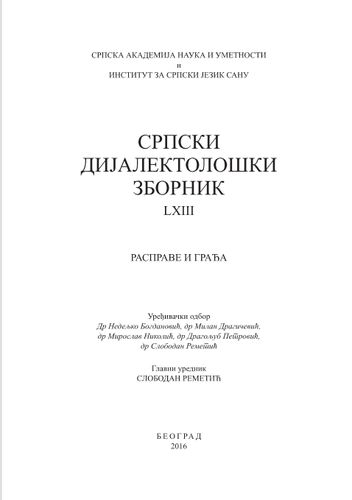Фонетске и морфолошке особине српских посавских говора између Врбаса и Укрине
Phonetic and morphological characteristics of the Posavina Serbian speechs between the Vrbas and the Ukrina rivers
Author(s): Dragomir V. KozomaraSubject(s): Phonetics / Phonology, Morphology, South Slavic Languages
Published by: Институт за српски језик Српске академије наука и уметности
Summary/Abstract: 1. The paper researches phonetic and morphological characteristics of the Serbian speeches in the Posavina region, placed between the Vrbas and Ukrina rivers, which belong to the group of younger Stokavian speeches of the Herzego- vina-Krajina (Eastern Herzegovian) dialect. According to the dialectal specificities and the areas they include, these speeches belong to the northwestern group of the Herzegovina-Krajina dialect, which is established according to the following characteristics: 1) Very often does one encounter the existence of a partial and total reduc- tion of the vowel и in the non-accented positions: vlàdika, godina, оtišla, spremili; godna, nedljom, vidćeš etc. 2) The Yekavian yat assimilation was not done as consistently as it was done in the southeastern speeches of this dialect. For example, it is common to hear one say: djevojka, djeca etc. 3) Names and hypocorisms of the types Rade, Jovo, Pero etc., are obligato- rily declined according to the pattern of female nouns ending in -a, and possessive adjectives derived from these nouns are formed with the suffix -in: Drago – Drage – Dragi – Dragu...; Dragin... 4) The verbal system is simplified. For example, the traces of imperfect are kept only in the form of bijaše/bješe, and of perfect participle in the deadjectival form of bivši, bivša etc. 5) The ending -i is regularly found in the second person singular of personal pronouns: meni, tebi, sebi. 6) The accent links of the types: idemo, pjevamo, čitamo, etc. are obligatory. 2. According to the dialectological classification, these speeches belong to the eastern branch of northwestern speeches of the Herzegovina-Krajina dialect, and the isoglosses which one uses for differentiating them from the speeches of the regions of Lika, Kordun, the north Dalmatia and the western parts of Banija and Kordun, are the following: 1) In numbers from ’11 to ’19, the vocalic sequence -ае- > e: dvanest, trinest... 2) The replacement of о > u next to nasal consonants is not a characteristic of these speeches. The examples of the type armunika, vaguni, uni and the like, are very rare. 3) The present forms of the verb jesti are regularly found in prosodic forms: jedem, jedeš, jede etc.
Journal: Српски дијалектолошки зборник
- Issue Year: 63/2016
- Issue No: 1
- Page Range: 579-731
- Page Count: 151
- Language: Serbian

